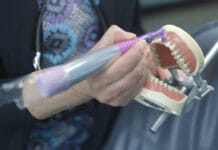I am always surprised and intrigued to discover new information through my patients. Recently, a patient (male, late 40s) proudly showed me his smartphone app and explained how it tracked his blood sugar, insulin, carbs, weight, and blood glucose levels. He wears a patch on his arm, which he changes every two weeks. Blood sugar levels and other information appear as graphs on the phone, allowing the patient to readily monitor his day-to-day fluctuations in blood sugar and glucose levels. It also correlates with daily activities, diet, and medications.
I was very impressed with the technology − accuracy without daily finger pokes. Now, that’s a smartphone. I was surprised when he told me that his previously diagnosed Type 2 diabetes was actually a misdiagnosis. He said that he really has Type 3c diabetes.
I had never heard of Type 3c diabetes. So, of course, I needed to do some research.
What is Type 3c Diabetes?
Also known as pancreatogenic diabetes mellitus (T3cDM), this is a form of secondary diabetes where the exocrine portion of the pancreas is diseased. This pancreatic disease develops prior to the development of diabetes.1
Researchers have also found a link between Type 3 diabetes and Alzheimer’s disease. Diabetes medications are being tested to treat insulin resistance in the brain.2 With the recent discovery of the link between periodontal disease and Alzheimer’s disease, and the known link between diabetes and periodontal disease, we should be curious about the possibility of a triangulation between the three (diabetes [T3cDM], periodontal disease, and Alzheimer’s).
Pancreatic diseases are uncommon. However, diabetes mellitus is common in patients with pancreatic disease and following pancreatic resection.
Roughly 10% of all diabetes cases could be classified as T3cDM. Most of these cases are initially misclassified as type 2 diabetes mellitus (T2DM). In chronic pancreatitis, diabetes has been observed in 26% to 80% of patients. Noting that alcohol toxicity is recognized as the most common etiology of chronic pancreatitis.3 This reinforces the relevance of having our dental health histories inquire about alcohol consumption.
Should I be Tested for T3cDM?
When there is an uncertain diagnosis of Type 2 diabetes, or current, regularly monitored treatment does not seem to manage the condition, consideration of evaluation for T3cDM should be suggested. Besides alcohol toxicity, familial history of T3cDM or pancreatitis should be investigated as well.
Causes of Type 3c Diabetes (T3cDM)
Chronic pancreatitis, cystic fibrosis, hemochromatosis (excess iron in the body), and pancreatic cancer.1
T3cDM Symptoms
Symptoms and signs include a history of pancreatitis with abdominal pain, steatorrhea (oily stool), maldigestion, nutritional deficiencies, and glucose intolerance,1 along with unmanaged Type 2 diabetes. Since there is a link between Type 3c diabetes and Alzheimer’s disease, symptoms may also include forgetfulness, memory loss, difficulty with daily tasks, misplacing things, poor judgment, or possibly a change in personality.
Type 3c Diabetes Treatment
Insulin therapy is the primary treatment for T3cDM; however, diagnosis is critical for proper treatment. Of course, balancing the right diet and exercise play a major role in controlling diabetes. Limiting sugars, soda intake, fermentable carbohydrates, and alcohol (which contains a large amount of sugar), sweet snacks, and excessive fruits will help manage your blood sugar levels.
Note: Limiting all of these substances will also improve your overall oral health. See the connection?
A1c guidelines
The typical A1c goal for most adults with Type 2 diabetes should be less than 7%. A1c is a two- to three-month measurement of your average blood sugar levels (blood glucose). The A1c test is designed to measure the amount of glucose entering the red blood cells and linking up with a hemoglobin protein. The lower your A1c level, the better your blood sugar level.
The Dental Link
As dental professionals, we know that studies have found that people with uncontrolled blood sugar levels often develop gum disease more frequently and more advanced than people with healthier blood sugar levels. Since diabetes slows circulation, gum tissues become more susceptible to infections such as periodontal disease.
The kicker is that people with serious gum disease (often due to too much sugar and fermentable carbohydrates) put themselves at higher risk for diabetes! Diabetes also puts one at risk for thrush, caries, and periodontal disease.
Conclusion
Study and question your patient’s health history. Ask what their A1c average is. Inquire whether their diabetes is well-managed. Encourage a healthy diet and exercise. Educate about the oral manifestations of diabetes and vice versa. If periodontal tissues are not stabilizing after thorough treatment, maintenance, and oral health promotion suggest further diabetes testing.
Need CE? Check Out the Self-Study CE Courses from Today’s RDH!
Listen to the Today’s RDH Dental Hygiene Podcast Below:
References
- Type 3C (Pancreatogenic) Diabetes. Med India. Retrieved from https://www.medindia.net/patientinfo/type-3c-diabetes.htm
- Type 3 Diabetes. Diabetes.co.uk: The Global Diabetes Community. Retrieved from https://www.diabetes.co.uk/type3-diabetes.html
- Gudipaty, L., Rickels, M. (2015) Pancreatogenic (Type 3C) Diabetes. Pancreapedia: Exocrine Pancreas Knowledge Base, DOI: 10.3998/panc.2015.35. Retrieved from https://www.pancreapedia.org/reviews/pancreatogenic-type-3c-diabetes












